Astronomers recently spotted a surprising “smiley face” beaming up from the surface of Mars as they surveyed the alien landscape as part of a new study. The emoticon-like structure, which is only visible under certain conditions, is the remnant of an ancient lake that dried up billions of years ago — and could be harboring signs of former life on the Red Planet.
The European Space Agency (ESA) shared an image of the smiley face in an Instagram post on Sept. 7. The grinning shape, which is made up of a ring of ancient chloride salt deposits with a pair of meteor-crater eyes, was snapped by ESA’s ExoMars Trace Gas Orbiter, which has been analyzing the levels of methane and other gases in Mars’ wispy atmosphere since 2016.
Normally, deposits like this would be indistinguishable from the rest of Mars’ surface. But when viewed using infrared cameras, like the ones on the ExoMars Orbiter, the salts appear pink or violet.
The photo was taken as part of a study, published Aug. 3 in the journal Scientific Data, in which researchers created the first robust catalogue of chloride salt deposits on Mars using images from the ExoMars Orbiter. In total, the team identified 965 different deposits scattered across the alien world, ranging in size from 1,000 to 10,000 feet (300 to 3,000 meters) wide. It is currently unclear how large the smiley face is.
These deposits are particularly important because they “can provide optimal conditions for biological activity and preservation,” which makes them “a prime target for astrobiological exploration,” researchers wrote in the paper.
Related: 15 Martian objects that aren’t what they seem
Mars was once a watery world, with lakes, rivers and a shallow ocean similar to those on Earth. But somewhere between 2 billion and 3 billion years ago, the water dried up after severe climate change. This was likely driven by the loss of Mars’ magnetic field, which allowed solar wind to gradually scrape away most of the planet’s atmosphere and eventually caused most liquid water to freeze or evaporate into space.
The salty deposits were left behind as the last water disappeared from Mars’ lakes at the end of the planet’s “dynamic aqueous past,” researchers wrote. In some locations, the leftover salts are the only evidence that there was any water there at all, they added. But these deposits could also have big implications for the search for evidence of ancient life on Mars.
The researchers believe that as Mars’ lakes began to shrink and disappear, the remaining water would have become very salty, allowing it to stay liquid despite temperatures as low as minus 40 degrees Fahrenheit (minus 40 degrees Celsius), according to a statement from ESA.
These last salty puddles “could have become a haven” for the microbial extremophiles that may have survived Mars’ transformation, causing their remains to accumulate in these deposits as the water finally dried up, the researchers wrote in the statement. If this happened, the salts could also have acted like a preservative — potentially keeping the evidence of these extinct lifeforms intact for billions of years.
Recent major discoveries also hint that Mars currently has much more water than we initially thought, which have retriggered hopes of finding living microbial Martians on the Red Planet in the future. In June, astronomers announced the discovery of “at least 150,000 tons” of water frost on the peaks of some of Mars’ tallest volcanoes. And in August, scientists revealed that an enormous hidden ocean — with enough water to cover the planet with 1 mile (1.6 km) of water — could be hiding below the Red Planet’s surface.
#Scientists #spot #ancient #smiley #face #Mars #signs #life



